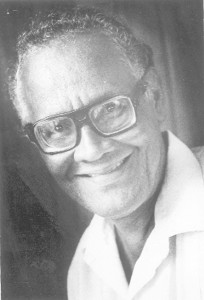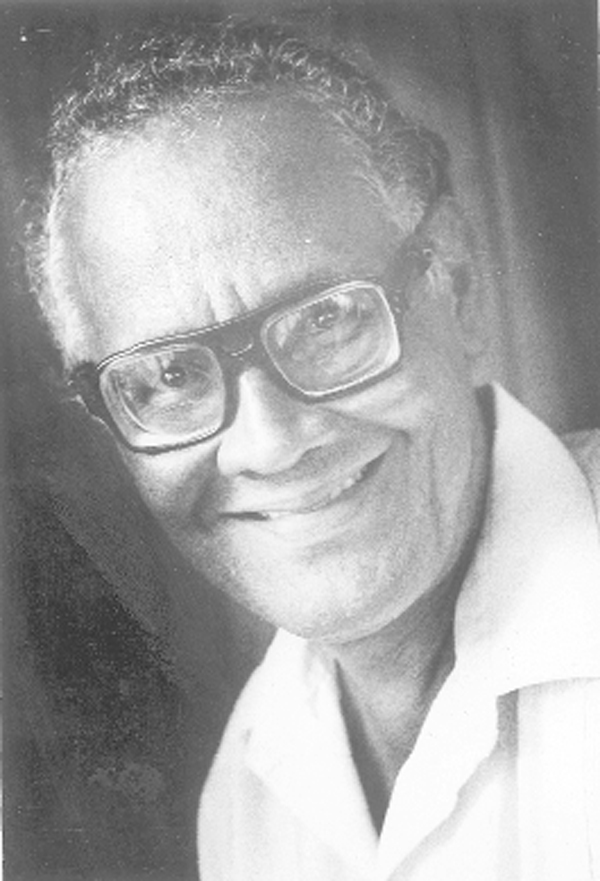Gemma Robinson is the editor of Martin Carter’s University of Hunger: Collected Poems and Selected Prose (Tarset: Bloodaxe Books, 2006).
Martin Carter died on December 13 eleven years ago. Gemma Robinson explores his relationship with David de Caires, and asks why we remember his poetry.
By Gemma Robinson
When do the words of writers slip from our memories? Literary history is full of stories of popular writers whose works are now only dimly remembered, if at all. Words and lines, once considered so key to understanding the times, quickly become anachronistic – locked in a context that no longer seems familiar. Imagery and forms, once read and repeated as defining beats in the contemporary artistic pulse, fade and we find ourselves wondering what we had once found so startling or truthful about such patterns of writing and figures of speech. Sometimes the lives of writers, rather than their words, are remembered most easily – the dates of their births and deaths duly noted and the places they lived lovingly memorialised. But these calendars and maps of remembrance can also be slowly emptied of meaning, when we no longer reflect on the importance of a day, or the yard we are passing.

Sharing the sad news that Stabroek’s editor-in-chief, David de Caires, had died, my friend ended his email writing, “when the news had sunk in, the first thing I did was reach for my Carter. I don’t need to tell you which poem.” Alissa Trotz, writing in memory of de Caires in her ‘In the Diaspora’ column, quoted from a public letter that Martin Carter wrote in 1964. The editorial in the Jamaica Gleaner read, “Thanks in part to David de Caires, Martin Carter’s ‘season of oppression, dark metal, and tears’ is not anymore so prevalent in Guyana. Indeed, the entire Caribbean is better off that he lived.” At de Caires’s funeral, Phyllis, Carter’s widow, read Carter’s great poem of loss, mortality and remembrance (the poem my friend in Port of Spain had turned to): ‘Death of a Comrade.’ From Georgetown to Port of Spain, Kingston to Toronto (and perhaps more places yet to be mapped) the life of Guyana’s great spokesman for and practitioner of the freedom of the press was remembered through the words of the poet who he had published and who had been his friend.
In an interview about their friendship and working relationship, de Caires remembered first meeting Carter in 1960 or 1961 and beginning to work with him in 1964, when New World Fortnightly was founded. Both were living in Georgetown, and the younger de Caires recalled his hope that Carter would publish in the magazine. Carter, reluctant to release work too quickly, had not published any poems for three years, and it was a piece of prose that he first offered to de Caires and Fortnightly’s co-editor, Miles Fitzpatrick. The goal of the magazine was to offer a forum for political and cultural debate that was non-partisan, but which interrogated the post-colonial future of Guyana and the Caribbean. The first issue began with Carter’s open letter:
“The almost fanatical preoccupation with hollow issues, the gossip-mongering which passes for conversation, and the inevitable political hysteria, leave little time for the serious examination of ideas. I know that the psychological squalor of everyday life is exhausting. I know that the urgent practical problem of making a living comes first. What I do not know is why so few revolt, either by word or by deed against such acute spiritual discomfort.”
These were the words that Alissa Trotz found, working her way through the old copy of a 44-year-old magazine, thinking of the life and times of David de Caires. Trotz notes that Carter’s condemnation of the intellectual dead end of “hollow issues,” “political hysteria” and “gossip-mongering” continues to be as provocative today as it was in 1964.
The question remained, though, how to act? Carter in the 1960s is often remembered as a man facing artistic and political disappointment, a man no longer confident about how to act poetically or politically. de Caires notes Carter’s conflict:
“It was strange. He stuck through it all, declaiming bitterly against the philistinism. As he used to say, ‘I can’t stand this trash, I won’t take it for another five minutes,’ but he took it for another thirty years.”1
In this period de Caires joined Carter and friends at the Carter house on Anira Street, where Carter’s mother and brother, Violet and Keith, lived. de Caires remembers these as both serious and humorous times.
“I would hear him teasing other people. If you came back from England, let us say, with a reputation of being a member of the Communist Party or something of that kind, and he met you he would say ‘Have you thawed out yet?’ Then if you made the mistake of saying you hadn’t, he would look at Keith [Carter] and say ‘Can’t help it, a young boy, you know, he don’t know better.’ Pouring scorn on idealism, but sort of tongue in cheek, but yet not really if you know what I mean. There was at that time a bantering air about him which was comic, but not really comic […]. He just became against failure. I don’t think he thought a solution was possible. Sometimes I would say ‘but what about this, and isn’t this possible?’ and he would look at Keith and [say] ‘can’t help it you know, born here.’ That’s a joke they used to play, ‘born here, you can’t help it.’ And then there would be laughter and so on. […] It was really amusing in some ways, but the underlying theme was a bitterness at failure.”
What should we conclude about Carter’s comments? For some it might reveal a pessimistic strain in his thinking. But I would not be too quick to assume this. Emotions on Anira Street ran high with a mixture of rum, politics and poetry. And the poetry and song that were animating their conversations – among them Yeats’s ‘Easter 1916’ and Spanish civil war songs – spoke across the Atlantic to them, and told of revolutions of the Irish against the British Empire, of a war against Fascism, but these revolutions also pitted Irish against Irish and Spanish against Spanish. These facts would not have been lost on this group, who had seen the anti-colonial movement crack and splinter in the 1950s, and saw decreasing hope of reconciliation in the 1960s.
Carter’s gallows humour targets himself as much as others. For the Carter brothers, to be Guyanese meant to look for possibilities of social change: “can’t help it you know, born here.” But to be Guyanese, to them at least, also meant being marked by the experience of political and social disappointment. Carter spent the 1960s trying to work out how to reconcile these opposing positions, and the work that was published in New World Fortnightly voices this contradiction. de Caires summarised what he saw as Carter’s attitude in the face of competing optimism and pessimism: “he just became against failure.” If a social solution was not immediately evident, Carter committed himself to understanding the complexities of Guyana, and facing the ‘failure’ wherever he found it. In ‘I Come from the Nigger Yard’ (1954) Carter writes of “leaping from the oppressor’s hate.” Ten years later, in ‘What Can A Man Do More,’ Carter returned to this vocabulary of energetic leaping, with an ambiguous combination of continued hope and disappointed experience:
And how to leap these sharp entanglements
or skirt this village of the angry streets?
How utter truth when falsehood is the truth?
How welcome dreams how flee the newest
lie?
In four lines of perfect iambic pentameter, Carter asked the pressing questions of his time: how to act, how to speak, how to hope?
If de Caires and Fitzpatrick had published only these poems, their work in New World Fortnightly would have been amply justified, but they continued to publish across the political and cultural divide, attempting to answer Carter’s question: ‘How utter truth?’ In 1964 they sought to write the future of Guyana’s independence. How far their dreams were realised is debatable, but it is safe to say that when Stabroek News was founded in the 1980s, de Caires knew that his dedication to a free press, investigative journalism and questions of truth had already been tested on the pages of New World Fortnightly. These magazines call out with renewed relevance today.
And with Carter, what outline of his life and work do we recall? We remember, I think, a man of integrity, who wanted to act well in the world, and who sought to face the complexities of action in his work. And each of us will have a poem we remember. In the end though, when thinking of Carter’s death and that of David de Caires, people turn to a short poem written in 1952 for a friend who drowned while swimming in Barbados. ‘Death of a Comrade,’ written in memory of Ivan Edwards, practises patience and calmness. It finds solace in nature when the human world seems so fragile. But do not doubt its challenge. It is an elegy that re-imagines death and nature, and in the following images Carter finds in nature a violent form of tranquillity: “for even now the greener leaf explodes / sun brightens stone / and all the river burns.” The images of the slow-motion ‘explosion’ of the leaf and the burning river suggest the violence and volatility of Carter’s natural surroundings. Remember, Edwards’ drowning made him a victim of a natural, as opposed to a man-made death. How easy, then, it would have been for Carter to rail against nature. Instead, though, Carter insists that we can always view the world with renewed understanding, by looking, for example, in detail at a leaf, stone and river, or by questioning the concepts which inform how we live our lives. In writing this elegy, Carter resolved to re-envisage and defy mortality and it is worth repeating its most quoted line: “Death will not find us thinking that we die.”
At 25 Carter understood that life was not always about what we can do, but what is done to us. What Carter’s poem lights upon is that remembrance and imagination can transform our losses – in life and in writing. What we then do with our memories is our further task. It is the norm, however, to forget rather than remember the words of writers. So when a poet consistently speaks to us and for us for more than half a century – as Carter has – our task should be to pause to remember the rarity of this experience.

